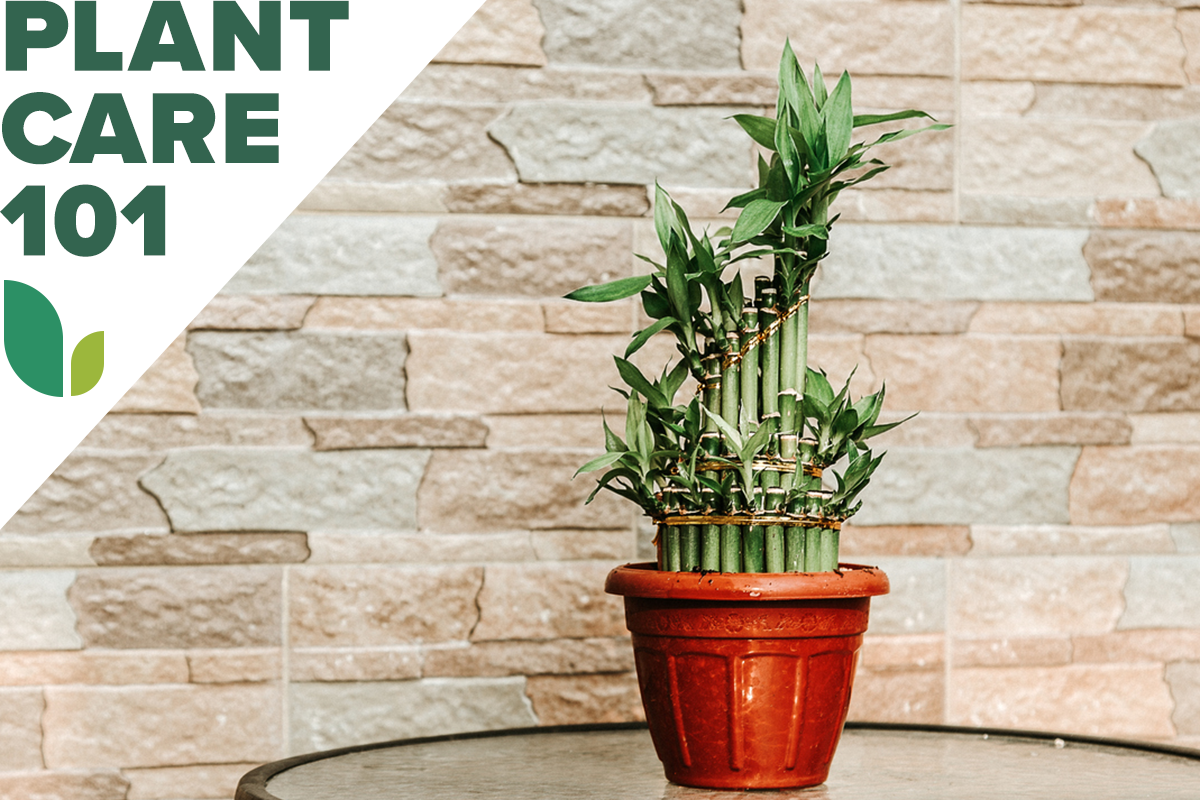

We may earn revenue from the products available on this page and participate in affiliate programs. Learn More ›
Lucky bamboo gets its name from a belief that the plant brings luck to those who receive it as a gift. And it makes an excellent gift, especially for beginner plant parents.
This popular houseplant contributes to good feng shui because of its association with bamboo, which represents sustainability, nobility, and openheartedness. Lucky bamboo can have either straight or curly stems, but when choosing a plant for its feng shui benefits, it’s best to choose a straight-stemmed variety, since those represent upward growth.
Read on for everything you need to know about lucky bamboo plant care, including its soil, light, water, and temperature needs.
Related: 5 Ways to Use Bamboo in Your Landscape
Lucky Bamboo Care at a Glance
Common name: Lucky bamboo
Scientific name: Dracaena sanderiana
Soil: Well drained, acidic
Light: Partial shade to bright or medium indirect light
Water: Keep soil moist
Food: Fertilize monthly with a drop of liquid fertilizer
Temperature and humidity: 65 to 90 degrees
Propagation: In water
Safety: Toxic to cats and dogs
Lucky Bamboo Characteristics
Dracaena sanderiana, more commonly known as lucky bamboo, is native to central Africa, though it is now grown largely in China and Taiwan. Despite its colloquial name, it’s not actually related to true bamboo. In fact, it’s part of the asparagus family known as Asparagaceae. Still, lucky bamboo resembles an actual mini bamboo plant, so it is an excellent easy care—and lucky—alternative.
Unlike bamboo, which has a wood-like stem, lucky bamboo has a softer, fleshy stem. Like bamboo, it grows quickly, and it can reach heights of 19 inches in just 6 months. The plant can grow to 39 inches, while the pale green leaves can be up to 9 inches long. The stem can grow in a straight, curly, or braided manner, and professional growers will train the stems into unique shapes.
In the wild, lucky bamboo is a flowering plant, but it will not flower when grown indoors. This bamboo-like plant generally is grown indoors in North America, but it can survive as an outdoor perennial in USDA Zones 10 and 11.
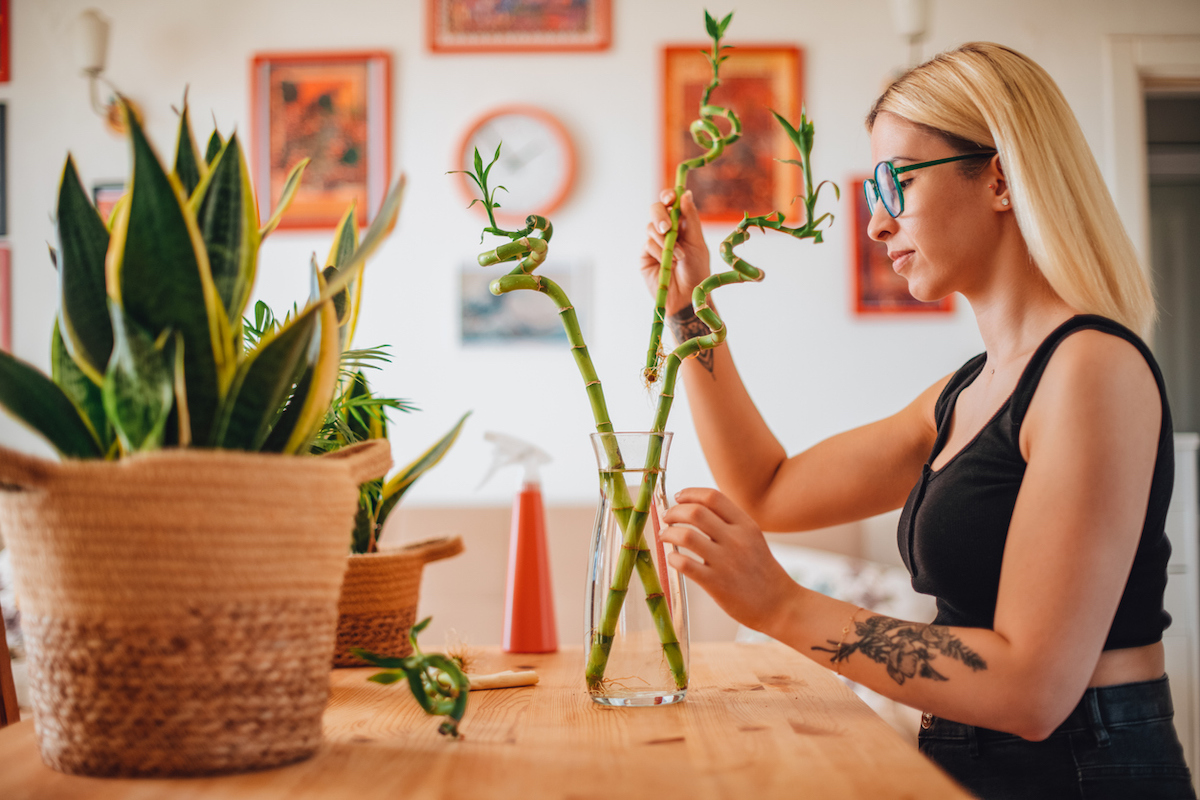
Types of Lucky Bamboo
- Green Lucky Bamboo: Dracaena sanderiana is the standard and most popular type of lucky bamboo, which can have multiple stalks and is popular in feng shui.
- White Stripe Victory: D. sanderiana ‘Victory’ has darker green leaves featuring white stripes.
- Lotus Lucky Bamboo: D. compacta has just one thick stalk with leaves coming out the top.
- White Stripe Gold: D. sanderiana ‘White Stripe Gold’ closely resembles white stripe victory, but has a cream-colored border on its leaves.
Selecting Soil for Lucky Bamboo
Lucky bamboo likes moist soil, so keeping the soil wet is crucial. Yellowing leaves could signify that the plant has become root-bound and needs to be repotted into a larger container to give the roots room to spread out.
Lucky bamboo can also grow in water with stones or pebbles to prop it up. Simply ensure it has at least an inch of water at all times, and it will thrive in a vase or other vessel. Change the water weekly for the best results, and clean the vessel thoroughly if you notice any algae growing in the water.
The Right Light
In nature, lucky bamboo generally grows under a leafy canopy of trees, so it does best when it receives bright indirect sunlight. Avoid placing your lucky bamboo plant in direct sunlight because the sun may burn its delicate leaves. If you notice the plant’s leaves turning yellow, it might be a sign that it’s getting too much sun.
Medium indirect light works for this versatile indoor plant. The lucky bamboo plant also tolerates low-light conditions, so it is an excellent choice for shady corners or offices that receive very little natural light.
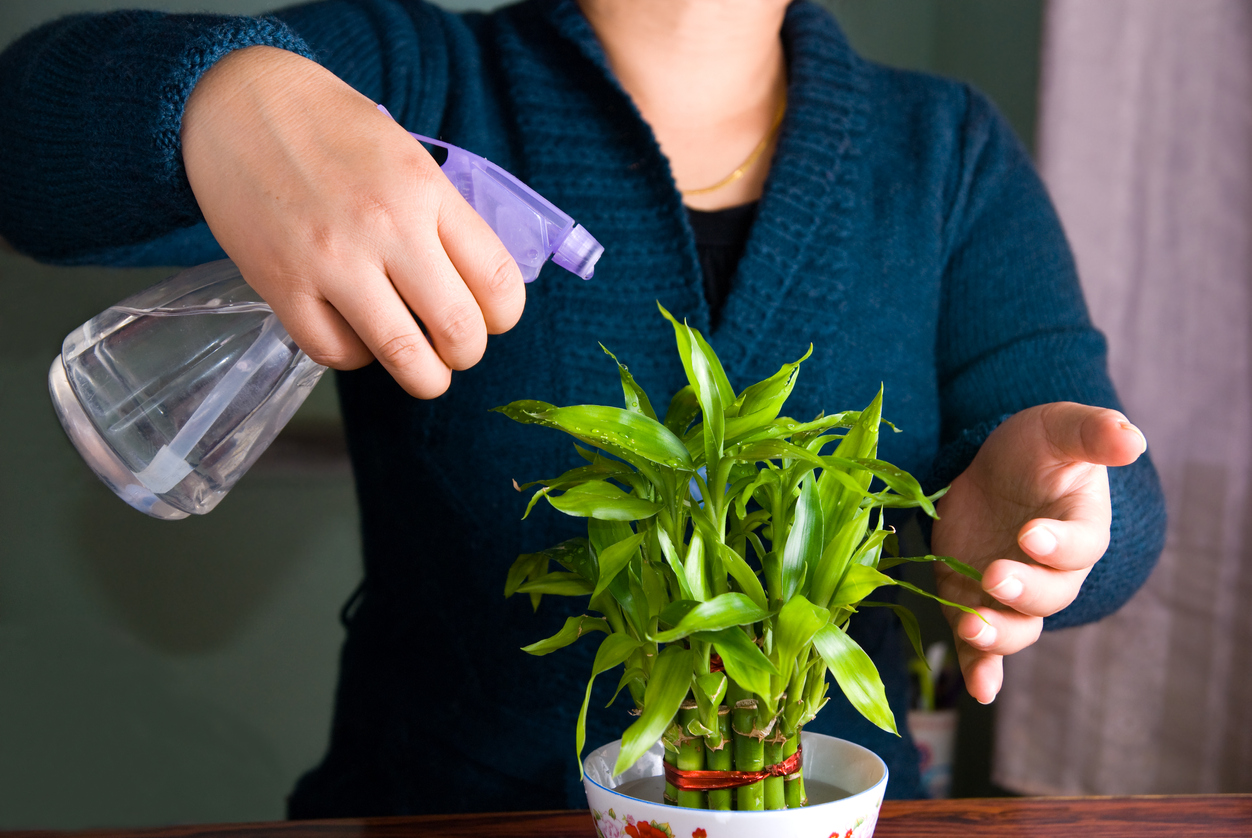
Watering Lucky Bamboo
While lucky bamboo is easy to care for in many ways, it can be a bit pickier when it comes to water. The plant does not tolerate chlorine, so regular tap water can have a negative effect, causing browning leaf tips and eventually killing the plant. Instead, water your lucky bamboo plant with filtered or bottled water for the best results.
Alternatively, you can let tap water stand on the counter overnight before watering your plant. Lucky bamboo plants do best in moist soil, so make sure to prevent the top layer from becoming dry.
Related: 12 Plants You Can Grow Successfully in the Shower
Fertilizing Lucky Bamboo
While there are specialty lucky bamboo fertilizers available, these hardy houseplants don’t have complex fertilization needs. When growing this houseplant in soil, fertilize it monthly using a drop of liquid houseplant fertilizer. When grown in water rather than soil, lucky bamboo plants can be fertilized every 2 months instead, using a heavily diluted liquid fertilizer. Yellow leaves are a sign of overfertilizing.
Setting the Temperature and Humidity
Due to its warm natural habitat, lucky bamboo does best in higher temperatures between 65 and 90 degrees Fahrenheit. Be sure to keep your lucky bamboo plant away from drafts from air conditioning vents or heaters. Lucky bamboo isn’t particularly sensitive to humidity, so there’s no need to monitor your home’s humidity levels.
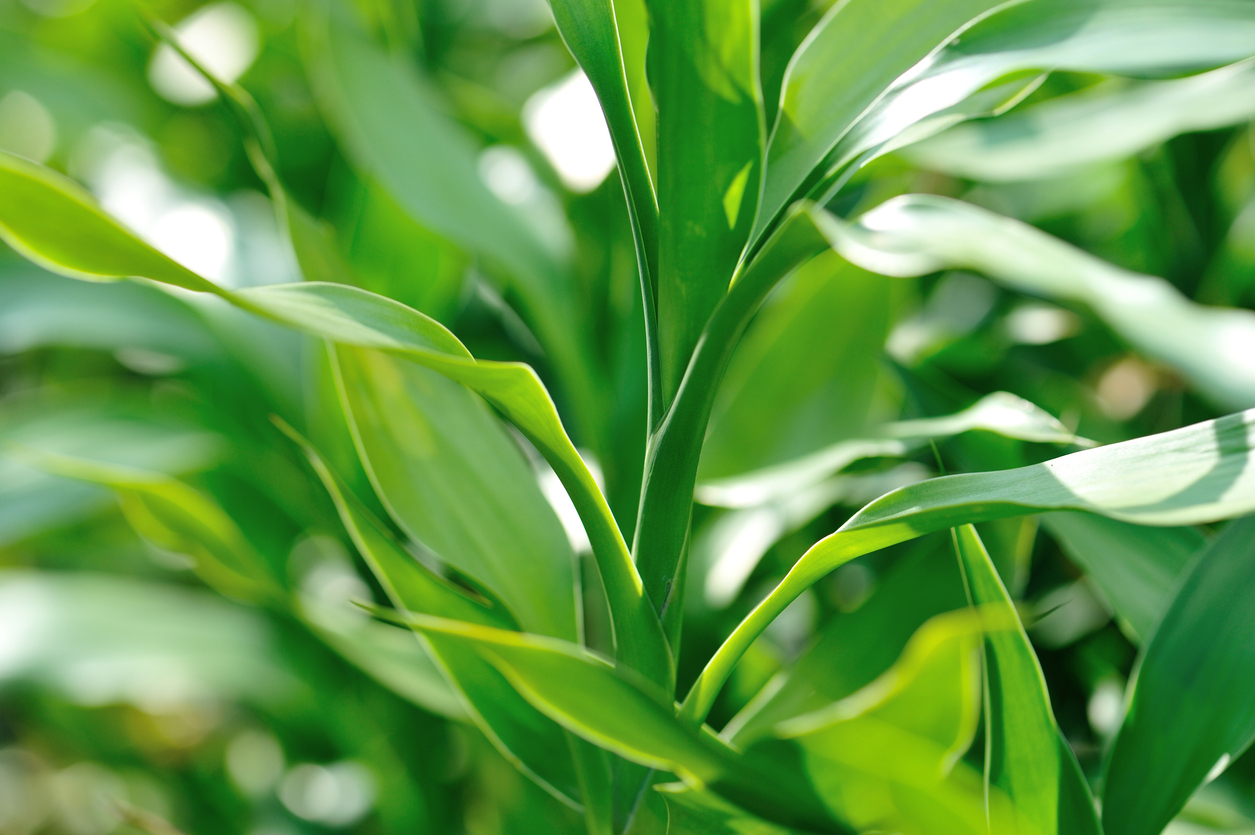
Propagating Lucky Bamboo
Once your lucky bamboo grows large enough, you can propagate it and give cuttings to friends and family members to bring good fortune to their homes. Lucky bamboo can be propagated all year long, regardless of whether the plant is in its growing or dormant season.
To propagate lucky bamboo, use a pair of sharp, clean scissors to cut the stem above one of the eyes. Make sure the cutting includes one leaf joint. Place the cutting in a container filled with filtered or distilled water, and allow it to root for 30 days. When the roots appear, they will be a bright red color. Once the roots have developed, the cutting can be planted in soil or kept in a vase.
Related: The Best Self-Watering Planters for Low-Maintenance Gardens, Tested
Safety Considerations
Pet owners must be wary when placing a lucky bamboo plant in their home because it can be toxic to both cats and dogs. Consuming lucky bamboo plants can cause vomiting, abdominal pain, diarrhea, coordination problems, and weakness. If you have pets, be sure to place your lucky bamboo plant on a high shelf where it’s out of reach. Lucky bamboo is not toxic to humans.
Potential Pests and Diseases
Like most other tropical houseplants, lucky bamboo is susceptible to infestations from pests like mealybugs, aphids, and mites. To prevent these pests, use neem oil or another natural insecticide to keep them at bay. If you notice bugs on your plant, you can remove them manually or rinse off the entire plant using water mixed with gentle dish soap.
Lucky bamboo is also susceptible to fungal infections. Gray fuzz on a lucky bamboo plant is a sure sign of a fungal infection. If this occurs, remove the affected portion of the plant and increase air circulation in the area to prevent future infections.
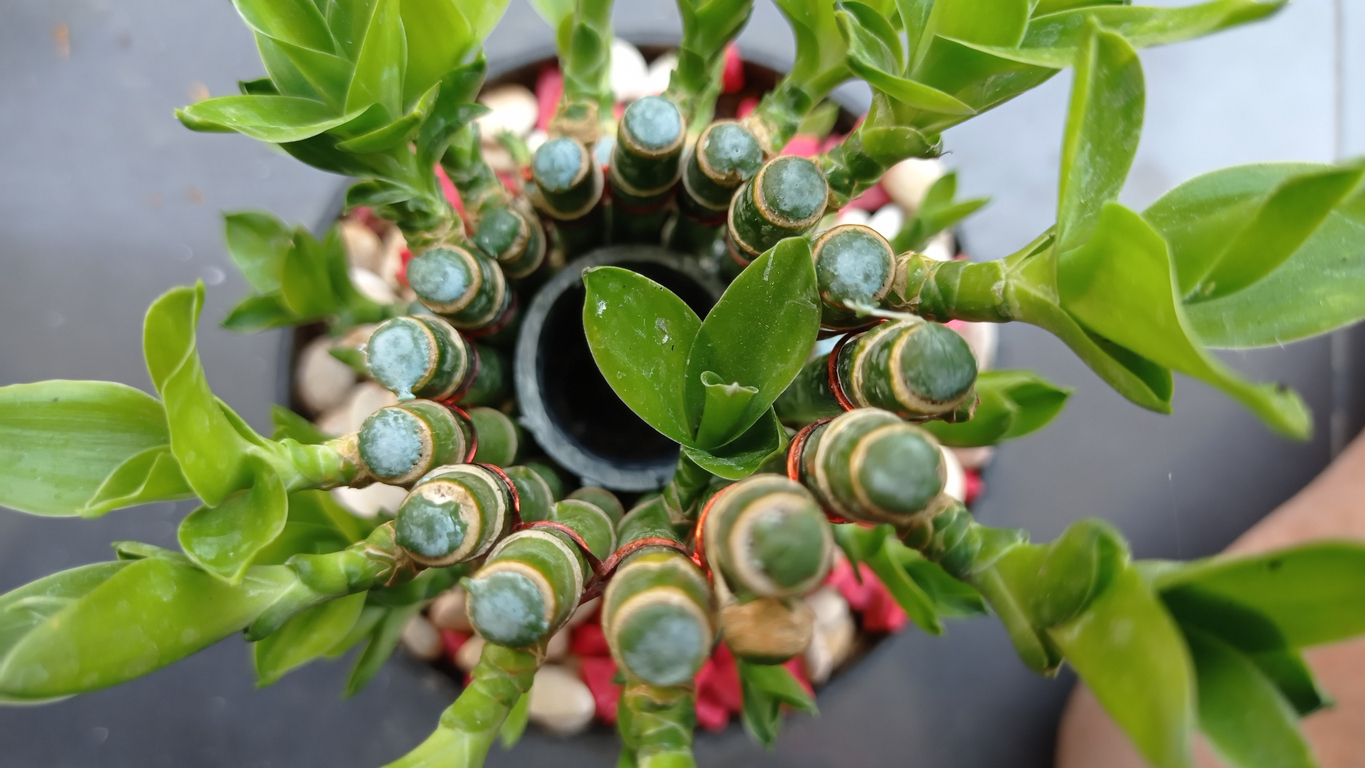
FAQs About Lucky Bamboo Care
While you’ve learned more about how to care for the lucky bamboo plant, you still might have some questions about its maintenance needs. Here are some common questions and answers.
While the plant can survive in either water or soil, lucky bamboo in soil will live longer, assuming you keep the soil from drying out completely.
Lucky bamboo prefers indirect sunlight or partial shade and can grow in medium or low light.
Lucky bamboo leaves turning yellow could be an indication that it’s getting too much sunlight, or it could be a sign that the plant is root-bound and needs to be repotted.
Place your lucky bamboo plant in indirect sunlight away from any heating or air conditioning vents. If you have pets, be sure to place the plant where they cannot get to it, since it is toxic to cats and dogs.
